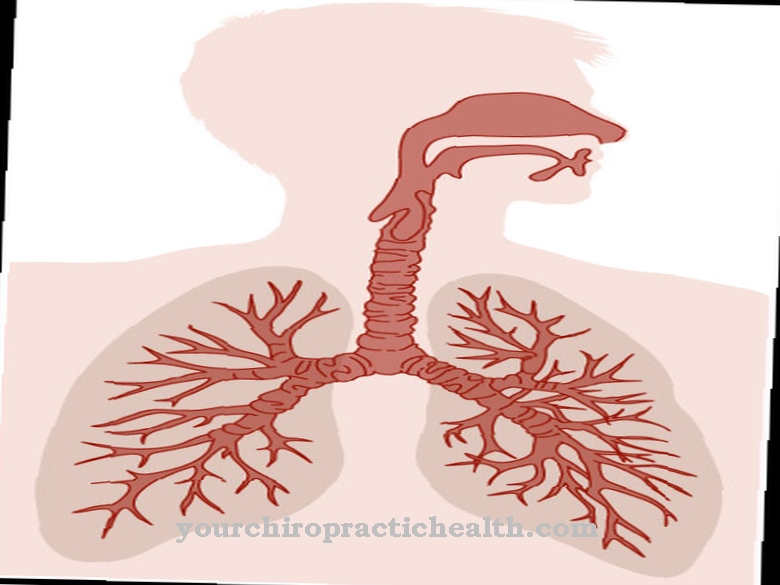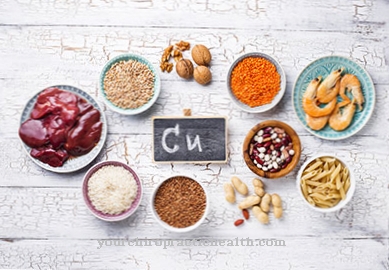Under the medical term Polyarthritis the doctor understands a simultaneous inflammation of several joints. One of the most common forms of joint inflammation is called rheumatoid arthritis. Furthermore, infections are often a reason why joint inflammation develops. Metabolic diseases can also be a cause.
What is polyarthritis?

If more than one joint is affected by inflammation, the doctor speaks of polyarthritis. The word arthritis is derived from the Greek "Arth" - the joint - and the word "Itis" - the "inflammation", whereby the term "poly" represents the plural meaning. If only one joint is affected by the inflammation, it is is monoarthritis.
A corresponding inflammation can occur spontaneously, which is referred to as acute arthritis. If the inflammation lasts longer or occurs again and again, the doctor speaks of a chronic disease, which is popularly known as rheumatism.
causes
There are different types and forms of polyarthritis. The most common causes are infections, metabolic diseases as well as autoimmune diseases and joint wear. In the case of infection, bacteria and other pathogens are responsible for the inflammation.
They enter through an open wound and then infect the affected joints. Classic pathogens are streptococci, staphylococci, salmonella, as well as Haemophilus influenzae and Escherichia coli. If there is an autoimmune disease, the own immune system attacks the joints. Typical autoimmune diseases that cause polyarthritis are psoriasis, Crohn's disease and ulcerative colitis, as well as ankylosing spondylitis or rheumatoid arthritis (rheumatism).
Chronic polyarthritis is one of the most common forms of joint inflammation. Metabolic diseases are also responsible for polyarthritis. Patients often suffer from polyarthritis when they have gout. The inflammation is triggered by the increase in uric acid, which is popularly known as a gout attack.
Symptoms, ailments & signs
Typical signs of polyarthritis are joint pain, which occurs predominantly at rest and is accompanied by swelling of the joints. Usually there is morning stiffness, which improves over time as the inflamed joints move. At the onset of the disease, the fingers and wrists of both hands are usually affected, whereby the finger end joints are spared from the inflammation.
The flexor and extensor tendons of the fingers can also be affected. In the further course of the process, the progressive breakdown of bone and cartilage causes malpositions of the corresponding joints, which lead to significant movement restrictions. The fine motor skills decrease significantly, later even everyday tasks such as tying shoelaces can no longer be performed.
Larger joints such as shoulders, elbows, hips or knees can also be affected by the disease. Involvement of the cervical spine is also possible; polyarthritic changes in other parts of the spine are atypical. In about 50 percent, the polyarthritis spreads to other organs.
There is often inflammation of the blood vessels, which can lead to circulatory disorders and coronary artery disease. Nerve damage in the area of the inflamed joints becomes noticeable through sensory disturbances, numbness, burning pain and occasionally paralysis. Infestation of the tear and salivary glands manifests itself in a dry mouth and dry eyes.
Diagnosis & course
In order to diagnose polyarthritis, the doctor needs several examination steps. He mainly collects the patient's medical history and asks him about any symptoms. This is followed by physical examinations and blood tests. The attending physician also takes an X-ray image of the affected joints.
First and foremost, the symptoms that the patients describe already give a relatively good insight into whether polyarthritis is present. However, in order to be able to provide an accurate diagnosis, the doctor must also answer the following questions, such as which joints are affected and which symptoms have occurred. It is also advantageous that the patient announces how long he has been suffering from the symptoms described. The fact whether the joint has been subjected to greater stress (e.g. due to different types of sport) or whether an underlying disease (e.g. gout) is present are decisive factors for the diagnosis.
The doctor examines the affected joint to see if there is any swelling or redness. Polyarthritis often has an increased level of inflammation in the blood. Classic features are an increase in leukocytes (the white blood cells), the rate of sedimentation and CRP (the C-reactive protein).
The course of the disease usually depends on why the polyarthritis developed. If it is an infection, the inflammation heals completely after timely treatment. In chronic forms of polyarthritis, it is possible that the inflammation process is slowed down. However, there is no cure, so the patient can expect the condition to deteriorate.
Complications
With polyarthritis there is a risk of various complications if the condition is not treated or treated incorrectly. There is a risk of secondary diseases, severe damage to the joints and a deterioration in quality of life. Chronic polyarthritis is a systemic disease.
This means that the inflammation can spread to internal organs like the lungs and heart. The same applies to the vessels.In the worst case, rheumatoid arthritis threatens to stiffen or deform the joints, causing disability. The sequelae of polyarthritis affect everyday things.
The affected person is sometimes no longer able to work on the computer because they can no longer use the mouse and keyboard. In addition, professional activities or everyday life are impaired. It is not uncommon for patients to suffer from disorders of their night's rest due to polyarthritis.
In the case of many sick people, these limitations in quality of life ultimately also affect their psyche. The affected people feel helpless or useless. In severe cases, there is a risk of anxiety and clinical depression.
A serious effect of polyarthritis is inflammation of the heart such as myocarditis (inflammation of the heart muscles) or pericarditis (inflammation of the pericardium). As a result, there is a risk of congestive heart failure. The heart is no longer able to conduct blood through the body without interference. Other possible complications of polyarthritis are anemia (anemia), osteoporosis (bone loss) or Sjogren's syndrome.
When should you go to the doctor?
Pain, discomfort, or irritation in the joints is considered unusual. If the symptoms persist, recur, or increase in intensity, a doctor is needed. If the irregularities are due to physical overuse, the affected areas should be cooled. After some time of rest and rest, there is usually relief and subsequent freedom from symptoms. A doctor is not required in these cases. If there is swelling, changes in the skin texture or morning stiffness, this is cause for concern. If mobility is impaired or if stretching and bending movements can no longer be fully performed, a doctor's visit is advisable.
A doctor is required in the event of a decrease in physical resilience, a slightly increased body temperature, a feeling of illness or general uncertainty about locomotion. If there are disorders of fine motor skills, a sensation of warmth in the joints and poor posture, a doctor should be consulted. If, in addition to physical irregularities, the person concerned also suffers from emotional or psychological abnormalities, consultation with a doctor is also necessary. Weepiness, depressive moods, withdrawal behavior or aggressive tendencies are indications of a health disorder that needs to be examined and treated. Sleep disorders, concentration problems and a loss of quality of life should be discussed with a doctor.
Treatment & Therapy
The therapy for polyarthritis depends on the cause of the inflammation. First and foremost, the affected joints need to be immobilized and cooled. Pain relievers help manage symptoms; Many doctors also prescribe anti-inflammatory drugs and glucocorticoids (better known as "cortisone").
Antibiotics also help with acute inflammation and special drugs against rheumatism. Many medical professionals also recommend surgery to relieve symptoms or cure the inflammation. Further treatment options are physiotherapy, occupational therapy and physical therapies.
In the case of chronic illnesses in particular, the latter therapy options are often used, as many patients already complain of "stiff" joints.
prevention
The patient can very well prevent polyarthritis. It is important that the joints are moved regularly and that there is an even load. This is favored with daily walks, cycling, gymnastics or swimming.
It is also important that injuries are treated in good time. In particular, open wounds (near the joints) should be treated accordingly so that no inflammation occurs in the joints. It is also important that underlying diseases, such as gout, are treated and treated regularly. Polyarthritis can only be prevented if the prescribed medication is taken regularly.
Aftercare
People affected by polyarthritis have only a few measures or options for follow-up care available, so that the first thing that should be done with this disease is to see a doctor as soon as possible to prevent further complications or symptoms. An early diagnosis usually has a very positive effect on the further course of the disease and can also prevent further complications.
Therefore, those affected should contact a doctor at the first signs and symptoms of polyarthritis. Most of those affected are dependent on taking various medications. The correct dosage and regular intake should always be observed in order to relieve the symptoms correctly and permanently.
When taking antibiotics, it should also be noted that they must not be taken together with alcohol. Furthermore, polyarthritis can be relieved well with the help of measures of physiotherapy or physiotherapy. The person affected can also do many of the exercises in their own home and thus speed up the treatment. Those affected are often dependent on the help of other people in their everyday life, whereby the help and care provided by their own family has a positive effect on the further course of the disease.
You can do that yourself
Polyarthritis is the best known form of rheumatic disease. If it is caused by chronic inflammation, it cannot be cured. Nevertheless, their course can be alleviated.
Dietary supplements such as the active ingredients chondroitin sulfate, N-acetyl-glucosamine and D-glucosamine sulfate can help with the drugs prescribed by the doctor. Chondroitin sulfate is a water-binding component of the body's own cartilage substance. It ensures that the joint cartilage remains elastic. Glucosamine sulfate is also a building material of the types of body tissue that make up cartilage, tendons and ligaments. N-acetyl-glucosamine is said to stimulate the cartilage cells to produce more collagen. The effects of the above-mentioned substances have been confirmed as often as refuted by studies, but some people affected find their use helpful.
Diet can also have a positive effect on polyarthritis. A base-rich diet is recommended so that the inflammation in the body is not further fueled. Therefore, the diet should be low in meat, but high in calcium and vitamins. Sour cherries or sour cherry juice are also said to reduce the inflammation levels in the blood. That's what scientists in Portland found out.
For many patients it is a relief when they can exchange ideas with other people affected. The German Rheumatism League (www.rheuma-liga.de) provides help for self-help, is represented in every federal state and can provide further information and contact points.



.jpg)























